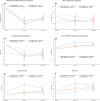Impact of personal genomic risk information on melanoma prevention behaviors and psychological outcomes: a randomized controlled trial
- PMID: 34385669
- PMCID: PMC8629758
- DOI: 10.1038/s41436-021-01292-w
Impact of personal genomic risk information on melanoma prevention behaviors and psychological outcomes: a randomized controlled trial
Abstract
Purpose: We evaluated the impact of personal melanoma genomic risk information on sun-related behaviors and psychological outcomes.
Methods: In this parallel group, open, randomized controlled trial, 1,025 Australians of European ancestry without melanoma and aged 18-69 years were recruited via the Medicare database (3% consent). Participants were randomized to the intervention (n = 513; saliva sample for genetic testing, personalized melanoma risk booklet based on a 40-variant polygenic risk score, telephone-based genetic counseling, educational booklet) or control (n = 512; educational booklet). Wrist-worn ultraviolet (UV) radiation dosimeters (10-day wear) and questionnaires were administered at baseline, 1 month postintervention, and 12 months postbaseline.
Results: At 12 months, 948 (92%) participants completed dosimetry and 973 (95%) the questionnaire. For the primary outcome, there was no effect of the genomic risk intervention on objectively measured UV exposure at 12 months, irrespective of traditional risk factors. For secondary outcomes at 12 months, the intervention reduced sunburns (risk ratio: 0.72, 95% confidence interval: 0.54-0.96), and increased skin examinations among women. Melanoma-related worry was reduced. There was no overall impact on general psychological distress.
Conclusion: Personalized genomic risk information did not influence sun exposure patterns but did improve some skin cancer prevention and early detection behaviors, suggesting it may be useful for precision prevention. There was no evidence of psychological harm.
© 2021. The Author(s).
Conflict of interest statement
The authors declare no competing interests.
Figures



Similar articles
-
The melanoma genomics managing your risk study: A protocol for a randomized controlled trial evaluating the impact of personal genomic risk information on skin cancer prevention behaviors.Contemp Clin Trials. 2018 Jul;70:106-116. doi: 10.1016/j.cct.2018.05.014. Epub 2018 May 23. Contemp Clin Trials. 2018. PMID: 29802966 Clinical Trial.
-
A Pilot Randomized Controlled Trial of the Feasibility, Acceptability, and Impact of Giving Information on Personalized Genomic Risk of Melanoma to the Public.Cancer Epidemiol Biomarkers Prev. 2017 Feb;26(2):212-221. doi: 10.1158/1055-9965.EPI-16-0395. Epub 2016 Oct 4. Cancer Epidemiol Biomarkers Prev. 2017. PMID: 27702805 Clinical Trial.
-
The Melanoma Genomics Managing Your Risk Study randomised controlled trial: statistical analysis plan.Trials. 2020 Jun 30;21(1):594. doi: 10.1186/s13063-020-04351-w. Trials. 2020. PMID: 32605576 Free PMC article.
-
National health strategies to reduce sun exposure in Australia and the United States.J Long Term Eff Med Implants. 2004;14(3):215-24. doi: 10.1615/jlongtermeffmedimplants.v14.i3.60. J Long Term Eff Med Implants. 2004. PMID: 15301665 Review.
-
Prevalence of sunburn, sun protection, and indoor tanning behaviors among Americans: review from national surveys and case studies of 3 states.J Am Acad Dermatol. 2011 Nov;65(5 Suppl 1):S114-23. doi: 10.1016/j.jaad.2011.05.033. J Am Acad Dermatol. 2011. PMID: 22018060 Review.
Cited by
-
Precision Public Health Initiatives in Cancer: Proceedings from the Transdisciplinary Conference for Future Leaders in Precision Public Health.BMC Proc. 2022 Jul 7;16(Suppl 4):4. doi: 10.1186/s12919-022-00234-x. BMC Proc. 2022. PMID: 35799197 Free PMC article.
-
Assessment of melanoma precision prevention materials incorporating MC1R genetic risk information.Transl Behav Med. 2022 May 26;12(5):683-687. doi: 10.1093/tbm/ibac034. Transl Behav Med. 2022. PMID: 35552458 Free PMC article. Clinical Trial.
-
Impact of polygeNic risk score for glaucoma on psycHosocial ouTcomes (INSiGHT) study protocol.PLoS One. 2024 Dec 26;19(12):e0312390. doi: 10.1371/journal.pone.0312390. eCollection 2024. PLoS One. 2024. PMID: 39724070 Free PMC article.
-
Are polygenic risk scores ready for the cancer clinic?-a perspective.Transl Lung Cancer Res. 2022 May;11(5):910-919. doi: 10.21037/tlcr-21-698. Transl Lung Cancer Res. 2022. PMID: 35693291 Free PMC article. Review.
-
Evaluating an approach for communicating integrated risk scores for melanoma.Eur J Hum Genet. 2025 Apr;33(4):523-530. doi: 10.1038/s41431-024-01750-4. Epub 2024 Nov 29. Eur J Hum Genet. 2025. PMID: 39613910
References
-
- Green AC, Williams GM, Logan V, Strutton GM. Reduced melanoma after regular sunscreen use: randomized trial follow-up. J Clin Oncol. 2011;29:257–263. - PubMed
-
- Elliott TM, Whiteman DC, Olsen CM, Gordon LG. Estimated healthcare costs of melanoma in Australia over 3 years post-diagnosis. Appl Health Econ Health Policy. 2017;15:805–816. - PubMed
-
- U. S. Preventive Services Task Force. US Preventive Services Task F, Grossman DC, Bibbins-Domingo K, Grossman DC, Curry SJ, Davidson KW, Ebell M, et al. Screening for skin cancer: US Preventive Services Task Force recommendation statement. JAMA. 2016;316:429–435. - PubMed
Publication types
MeSH terms
LinkOut - more resources
Full Text Sources
Medical

